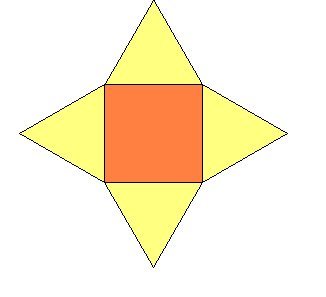Hello, hello! and welcome back. Last time I reported on my progress, we had a look at how my 3D model of the asset required for my assessment, (a treasure chest) is looking.
I am glad to say, that this has now been completed, and now I’m ready to post an update about the next stage of the pipeline- my treasure chest’s UV wrap.
I’m struggling to come up with a comparison other than, a ‘net’ of a 3D shape that would describe UV unwrapping in a logical sense, so unfortunately that’s what you’re getting. UV unwrapping is HIGHLY important and plays a huge part in texturing later on. If you do a rushed job, it will certainly show.

a 2D net of a Square based pyramid
Where to begin? This was also a lengthy process, and I learnt another important lesson about the problems you will run into when trying to prepare your UVs (those letters are interchangeable for X and Y by the way), with sunken vertices. Again this was due to a silly mistake ( I left the dreaded lock selection on) and although easily fixed, with some solid advice and a little bit of help from those who know better than I, this also was something I worked through slowly.
The checker pattern is merely used to get a good idea of the scale of the UVs on each part. All sides have to be the same in scale, unless you are deliberately choosing to make a specific part more low-res than another. (When following the tutorial, it was advised to make the UVS on the bottom of the chest a lower res than the other sides by making it smaller than the others.)
Eventually though, I found unwrapping to be relaxing after getting the hang of the controls and I think I can say I did learn through my mistakes.
I learned that making a good UV map is all about patience.
After all the UVs are projected correctly onto the UV canvas, the final step is to render out a uv map. This can be described as the guidelines for your texture.
This brings me to the next part of the post; texturing.
I went about texturing by attempting to follow along with the video tutorials given to us. This was one of the more successful stages of the build. I hardly ran into any soul-sucking, headache inducing trouble and was able to finish this in about a day.
The first step in texturing, is to open up your UVs in an image editing program, such as Photoshop, Gimp or Paint.net. I chose to use Photoshop to edit mine.
I followed the guide and began setting up my image ready for outlining.
This is a fairly straightforward process, and it really does help to switch back into 3Ds max every now and then, just to see how your image is going. (Make sure to apply your image at a material in order to keep an eye on how things are going.)
Important details such as highlights and shadows are added for dramatic effect.
Finally, I opted to leave my treasure chest as it appears in the photo above the previous, for a more rustic look, rather than adding the fine detailing. Mostly due to time restrictions, however the finished product minus the extra detailing still has some nice visual aesthetics.






















